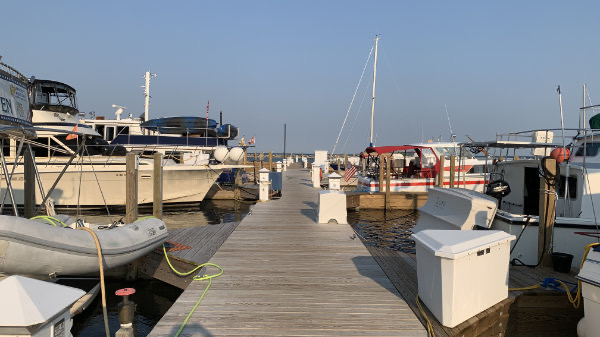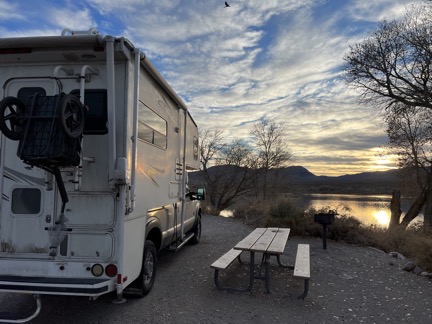The two activities are remarkably similar.
I’m sure I bored Capt Paul on Nano with my never-ending comparisons between cruising and camping (and flying, for that matter). In the beginning, I was constantly asking him questions about and observing things like navigation and using marinas. And then, when my mind started equating these new activities to things that were familiar to me, I drew comparisons. Over and over. Ad nauseam.
They really are a lot alike. And because of that, a lot of the experience I’ve gained as a long haul RVer — someone who stays away from home for more than a month at a time — can easily be applied to future activities cruising on a boat. I thought I’d take a moment to run through a few; if you’re an RVer or a cruiser, you might learn a bit about the activity you’re not familiar with.
Things That Are Very Similar
Planning
Planning an RV road trip is a lot like planning a cruise in that you have to gather all of the information you can about the route, weather, desired destinations, and alternative destinations. You need to plan for where you can get fuel, where you can park overnight, where you can replenish supplies such as water and groceries, and where you can dump or pump out the blackwater tank. During the information gathering process, you learn as much as you can about roads/waterways and facilities along the way. This includes reading reviews left by other travelers to help you make informed decisions. Even if you start with a thorough plan for the trip, you have to be prepared to make changes to that plan to take advantage of new opportunities or handle unexpected problems. As someone who has traveled — usually alone — with an RV for about fifteen years, I feel as if I’ve been trained and tested on my abilities to make plans, change plans, and take care of problems as they come up. This skill will come in handy on a boat.
Navigation
In both activities, you need to find your way from point A to point B. With a camper, you do this on roads; in a boat, you do this on established waterways. In both activities, there are restrictions. For example, when I travel with my camper, I can’t take any road that doesn’t offer at least 12 1/2 (or 13, to be safe) feet of head clearance. I also need to avoid roads that are very rough or have soft sand so I don’t get stuck. Likewise, in a boat, you need to worry about head clearance — especially in the case of navigating canals and small waterways — but also about water depth.
Weather
Yes, I can drive my truck camper in high winds or rain or even snow. But do I want to? Is it safe? Ditto for traveling on the water. Wind and waves make potentially dangerous — or at least uncomfortable conditions. Either way, it’s important to check the forecast when planning the day’s travel.

These days, I’m spending two of every seven to ten days at a campground. I expect to spend about the same at marinas once I’ve become accustomed to cruising and anchoring out.
Campgrounds / Marinas
I cannot stop drawing comparisons between campgrounds and marinas. They can offer a variety of services — the same services! Power, water, sewer dump/pump out. Restrooms, showers, laundry facilities, wifi, supply shop, pool. Logo merchandise, souvenirs. Social and recreational opportunities. They both cost money and many directly or indirectly charge you based on the size of your camper/boat.
Free Campgrounds / Docks
These are a little harder to find, but they do exist: free facilities that offer some of the features you might find at a pay campground/marina. I’m staying in one right now: a nice little campground on a lake with developed campsites that have picnic tables, fire pits, and grills. There are even a handful of toilets. When I cruised on Nano, there were lots of free docks on the Erie Canal; several had access to power, water, and restrooms with showers.

Here’s my camper, parked at a free campground in Nevada that offers picnic tables, grills, fire pits, and access to a lake filled with migratory birds — and not much else.
Boondocking / Anchoring Out
In the RVing world, boondocking refers to parking someplace where you have no facilities — you’re limited to what you have with you. My camper is set up perfectly for boondocking; it holds fresh and waste water, has a water pump, water heater, toilet, shower, stove, oven, refrigerator, sink, etc. Solar panels keep the batteries charged, and I bring along a 2 kw generator just in case there isn’t enough sun to get the batteries charged. I find a suitable place — usually public land out in the desert or up a mountain road or sometimes, if I’m in transit and just want overnight parking for an early start in the morning, in a Walmart or Cracker Barrel parking lot — and park there for free. I make myself comfortable with what I have with me. The equivalent in the boating world is anchoring out for the night. You have to find a suitable place, drop anchor, and do what’s necessary to make sure you don’t drift. Then you make yourself comfortable with whatever you have on board. The trick in both activities is to find someplace safe and secure and, hopefully, quiet.
Packing Light
Whether you’re in a camper or on a boat, space is limited. You quickly learn to bring only what you really think you’ll need. When you have too much stuff with you, it’s constantly in your way. :Even shopping for food becomes a tricky task; you can’t buy more than will fit in your refrigerator or cabinets and you often have to shed bulky packaging before loading groceries on board.
Staying Organized
One of my biggest problems is that I live a cluttered lifestyle at home. When you have a lot of space and a lot of stuff and can’t seem to get rid of stuff or put it away you get clutter. I know why this happens and I know how to fix it. Although I don’t fix it at home, I’ve learned how to fix it in my camper. The reason: when there’s a tiny amount of space and its cluttered up with things you don’t need or aren’t currently using, it makes life miserable. So I’m constantly putting things where they belong or getting rid of them completely. As a result, my living space is relatively neat and clean unless I’m in the middle of a project — like planning a day’s activity, writing a blog post, or studying for my Captain’s license. This skill will be invaluable on a relatively small boat, especially since just stowing things outdoors on the ground will not be an option.
Conserving Power
Because my camper has just two batteries that, when I’m not in transit or plugged in somewhere are charged by a solar panel, I’ve learned to shut things off when I’m not using them and plan my activities around when the sun will replenish power. For example, washing dishes requires the use of a power sucking water pump; that’s why I always wash my dishes in morning or during the day when the sun is on those panels and can replenish the power I used. While I’ll have a generator available when necessary, who wants to listen to it if they don’t have to?
Conserving Water
There isn’t much water out in the desert when I’m boondocking and my camper only carries 30 gallons of fresh water in its tank. I have become very good at conserving water — so good that I can make that 30 gallons last nearly a week. Yesterday, for example, when I decided that I really need to clean my camper’s windows, which were covered with a white film from driving though a snowy area, I filled a basin with water from the lake behind my campsite rather than use a gallon or more from the onboard tank. (It wasn’t as if I were going to drink it or wash my dishes with it.) Boats have similar limitations, especially if you’re boating in salt water. While I’m not opposed to putting filtered lake water into my holding tank for washing and showering, I would never put salt water in it. Water desalination systems are expensive and power-hungry; it would be nice to do without one.
Toilet / Shower Use
Both my camper and Nano have a wet bath — that means that the shower and the toilet share the same space. There’s a limit to the amount of hot water and showering makes a mess. (It does, however, offer an opportunity to clean the bathroom thoroughly since you need to towel it out after a shower.) I shower in my camper when I have to, but certainly not daily. I never showered in Nano. And because there’s a limit to what you can put in the holding tanks, it’s best to do your business elsewhere — like at a campground/marina or restaurant along the way — when you can. I have had some excellent showers at truck stops (really!) and a few pretty good ones at marinas while cruising on Nano. The less you put in the blackwater holding tank, the less often you need to tackle the dirty job of emptying it.
Things That are Different
Toilet / Head
This was a surprise to me. In the RV world, toilets are usually gravity flush and, with a limited size tank that has to be dumped in a proper facility, the less you put into them, the better off you are. I learned to flush with very little water. This became a problem on Nano since the head worked with some sort of pumping system and you had to flush until the water you could see beyond the bowl was clear. I estimate that it takes at least 4 times as much water to flush a boat’s head than an RV’s toilet. That means you are using more fresh water and putting more in the tank so you’ll have to dump/pump out more frequently. (Another reason to use public restrooms.)
Parking Hazards
When I park my camper in a secure spot — a flat piece of desert, a marked campsite, a parking lot — I don’t expect it to move. Hell, I usually don’t even set the parking brake. But things are different in a boat. Yes, if you tie off properly in a marina slip or at a dock, your boat should stay where you put it. But anchoring out overnight introduces all kinds of new challenges that are related to the movement of water (current and/or tide) and wind. I will definitely follow all anchoring recommendations when I anchor out and make use of anchor warnings that are widely available in navigation software for boaters.
The Bottom Line
At the end of all this, I’ve come to realize that I am well prepared to move my travels from hitting the road with an RV to hitting the waterways with a live-aboard boat. While I still lack a lot of raw boating experience in unusual circumstances — mostly challenging weather and water conditions — I have the logistical aspects worked out better than a lot of folks might. The fun will come in putting a long trip together and seeing it through from beginning to end — and learning from that experience.
I live to learn and I can’t express how much I’m looking forward to the cruising lessons ahead of me.


